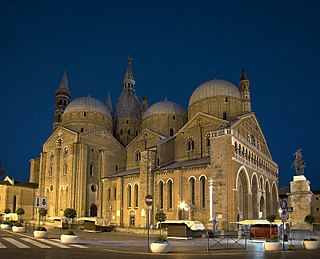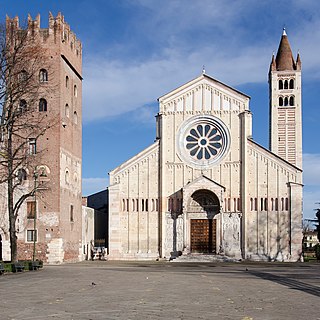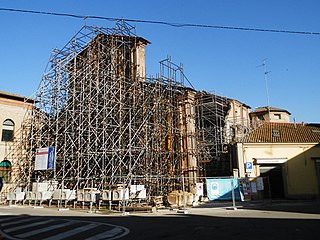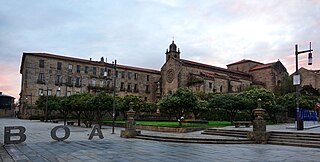
Cathedrals, collegiate churches, and monastic churches like those of abbeys and priories, often have certain complex structural forms that are found less often in parish churches. They also tend to display a higher level of contemporary architectural style and the work of accomplished craftsmen, and occupy a status both ecclesiastical and social that an ordinary parish church rarely has. Such churches are generally among the finest buildings locally and a source of regional pride. Many are among the world's most renowned works of architecture. These include St Peter's Basilica, Notre-Dame de Paris, Cologne Cathedral, Salisbury Cathedral, Antwerp Cathedral, Prague Cathedral, Lincoln Cathedral, the Basilica of Saint-Denis, Santa Maria Maggiore, the Basilica of San Vitale, St Mark's Basilica, Westminster Abbey, Saint Basil's Cathedral, Antoni Gaudí's incomplete Sagrada Família and the ancient cathedral of Hagia Sophia in Istanbul, now a mosque.

The Basilica di Santa Maria Gloriosa dei Frari, commonly abbreviated to the Frari, is a church located in the Campo dei Frari at the heart of the San Polo district of Venice, Italy. It is the largest church in the city and it has the status of a minor basilica. The church is dedicated to the Assumption of Mary.

Cosenza is a city in Calabria, Italy. The city centre has a population of approximately 70,000, while the urban area counts more than 200,000 inhabitants. It is the capital of the Province of Cosenza, which has a population of more than 700,000. The demonym of Cosenza in English is Cosentian.

The Basilica of Saint Francis of Assisi is the mother church of the Roman Catholic Order of Friars Minor Conventual in Assisi, a town in the Umbria region in central Italy, where Saint Francis was born and died. It is a papal minor basilica and one of the most important places of Christian pilgrimage in Italy. With its accompanying friary, Sacro Convento, the basilica is a distinctive landmark to those approaching Assisi. It has been a UNESCO World Heritage Site since 2000.

The Basilica of San Petronio is a minor basilica and church of the Archdiocese of Bologna located in Bologna, Emilia Romagna, northern Italy. It dominates Piazza Maggiore. The basilica is dedicated to the patron saint of the city, Saint Petronius, who was the bishop of Bologna in the fifth century. Construction began in 1390 and its main facade has remained unfinished since. The building was transferred from the city to the diocese in 1929; the basilica was finally consecrated in 1954. It has been the seat of the relics of Bologna's patron saint only since 2000; until then they were preserved in the Santo Stefano church of Bologna.

The Pontifical Basilica of Saint Anthony of Padua is a Catholic church and minor basilica in Padua, Veneto, Northern Italy, dedicated to St. Anthony of Padua.

Padua Cathedral, or Basilica Cathedral of Saint Mary of the Assumption, is a Catholic church and minor basilica located on the east end of Piazza Duomo, adjacent to the bishop's palace in Padua, Veneto, Italy.

The Basilica di San Zeno is a minor basilica of Verona, northern Italy constructed between 967 and 1398 AD. Its fame rests partly on its Romanesque architecture and partly upon the tradition that its crypt was the place of the marriage of Shakespeare's Romeo and Juliet. It stands adjacent to a Benedictine abbey, both dedicated to St Zeno of Verona.

Gothic architecture appeared in the prosperous independent city-states of Italy in the 12th century, at the same time as it appeared in Northern Europe. In fact, unlike in other regions of Europe, it did not replace Romanesque architecture, and Italian architects were not very influenced by it. However, each city developed its own particular variations of the style. Italian architects preferred to keep the traditional construction methods established in the previous centuries; architectural solutions and technical innovations of French Gothic were seldom used. Soaring height was less important than in Northern Europe. Brick rather than stone was the most common building material, and marble was widely used for decoration. In the 15th century, when the Gothic style dominated both Northern Europe and the Italian Peninsula, Northern Italy became the birthplace of Renaissance architecture.

Santa Maria del Carmine is a church in Pavia, Lombardy, northern Italy, considered amongst the best examples of Lombard Gothic architecture. It was begun in 1374 by Gian Galeazzo Visconti, Duke of Milan, on a project attributed to Bernardo da Venezia. The construction followed a slow pace, and was restarted in 1432, being finished in 1461.

San Francesco is a 13th-century, Roman Catholic church located on via Berrettini in Cortona, region of Tuscany, Italy.

The Cathedral of the Good Shepherd located in the city of San Sebastián, Gipuzkoa, Basque Country, Spain. It is the seat of the suffragan Diocese of San Sebastián and subordinated to the Archdiocese of Pamplona y Tudela. The most remarkable religious building of San Sebastián, it is endowed with a strong verticality and is the largest in Gipuzkoa. Its construction took place in the last years of the 19th century in a Historicist Neo-Gothic style. The church, dedicated to the Good Shepherd, has held the rank of cathedral since 1953.

Santa Sofia is the oldest Roman Catholic church structure in the city of Padua, region of Veneto, Italy. It was built in the 10th century on the site of a presumed Mithraeum. A grant was made to bishop Sinibaldo of this church in 1123, which had already been in construction. The Romanesque stone and brick facade was constructed from 1106 to 1127, but the semicircular apse may date from earlier. The interior is now relatively bare.

Otranto Cathedral is a Roman Catholic cathedral in the Italian city of Otranto, dedicated to the Annunciation of the Virgin Mary. It is the archiepiscopal seat of the Archdiocese of Otranto. The cathedral was consecrated in 1088. It is 54 metres long by 25 metres wide and is built on 42 monolithic granite and marble columns from unknown quarries. Its plan is a three-aisled nave with an apsidal east end. On either side of the west façade are two lancet windows.

Santa Maria dei Servi, or simply known as the Chiesa dei Servi, or more fully as the Church of the Nativity of the Servants of the Blessed Virgin Mary, is a 14th-century, Roman Catholic church that faces the Via Roma in Padua, region of the Veneto, Italy. This is a parish church in the vicariate of the Cathedral Basilica of Santa Maria Assunta governed by the Servite Order. The church contains outstanding works of art including a wooden crucifix by Donatello.

The Convent of Saint Francis is a Franciscan convent located in the western, historic center of Fiesole in the region of Tuscany, Italy.

The church of San Francesco is a church located in Mirandola, in the province of Modena, Italy.

The Convent of St. Francis is a Franciscan convent located in the city centre of Pontevedra (Spain), overlooking the Plaza de la Herrería. The Gothic church of San Francis is attached to the convent on the southeast side.

The church of San Francesco of Assisi is a Catholic religious building in Pavia, Lombardy, Italy.





















